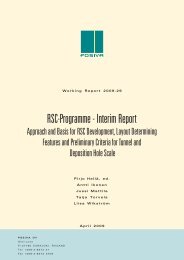Bentonite Mineralogy Part 1: Methods of Investigation - Posiva
Bentonite Mineralogy Part 1: Methods of Investigation - Posiva
Bentonite Mineralogy Part 1: Methods of Investigation - Posiva
Create successful ePaper yourself
Turn your PDF publications into a flip-book with our unique Google optimized e-Paper software.
31<br />
Table 6-2. Instrumental detection limits <strong>of</strong> major elements. Limits are given only for the<br />
elements that were determined using the respective method.<br />
Element Detection limit (mg/k2)<br />
XRF ICP/AES S/C-analyzer<br />
Al 100<br />
Ca 50 5<br />
Fe 200<br />
K 50 5- 10<br />
Mg 200 1 - 5<br />
Mn 40<br />
Na 500 3<br />
s 100 100<br />
c 100 100<br />
Table 6-3. Detection limits <strong>of</strong> minor elements, XRF<br />
6.1 X-ray powder diffraction<br />
6.1.1 Bulk samples<br />
Detection<br />
limit (m2/k2)<br />
Elemets<br />
60<br />
p<br />
30 As, Bi, Ce, Cr, Ga, La,<br />
Pb, Sb, Se, Sn, Ti, V, Y<br />
20 Ba, Cu, Ni, Zn<br />
10 Mo, Nb, Rb, Sr, Th, U,<br />
Zr<br />
Bulk samples were mixed with acetone and ground using agate mortar and pestle. The<br />
thick slurry was spread evenly on a glass slide and let to dry at ambient temperature.<br />
Acetone was used to allow rapid drying and, consequently, diminish preferred<br />
orientation <strong>of</strong> platy sheet silicate particles. Two or three mounts were prepared <strong>of</strong> each<br />
sample because the diffractograms were used for semiquantitative evaluation <strong>of</strong> mineral<br />
composition. Most <strong>of</strong> the samples are raw material and therefore heterogeneous. MX-80<br />
is homogenized and Milos activated and Friedland ground to very fine-grained powder.<br />
The XRD data was collected on a Philips X'Pert diffractometer equipped with a vertical<br />
goniometer, a diffracted beam monochromator and a rotating sample holder at the<br />
Research Laboratory <strong>of</strong> the Geological Survey <strong>of</strong> Finland. CuKa-radiation was used<br />
and the applied voltage was 40 kV with a 55 mA current. The patterns were recorded<br />
from 2 to 70°20. The counting time was 1 s per 0,02°20. The position <strong>of</strong> the smectite

















